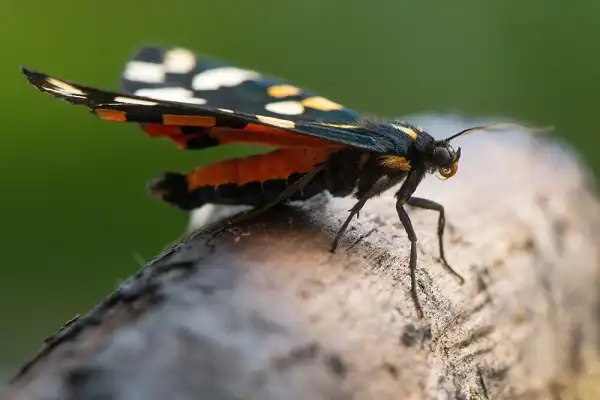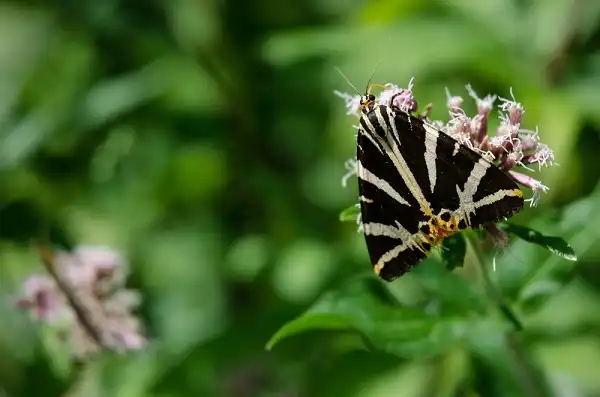Are you interested in learning more about one of the world’s most iconic insects? Tiger moths are spectacular creatures that have captivated and delighted viewers for centuries. From their vibrant colors to their unique life cycle, these fascinating moths offer a wealth of wonders for those lucky enough to spot them in the wild. In this blog post, we’ll be exploring all aspects of these amazing animals, from what they look like and where they can be found to how they fit into our natural environment. So put on your explorer’s hat and join us as we explore the wonderful world of tiger moths!

Tiger Moth Description
Tiger moths, scientifically known as Arctiinae, are a large group of moths known for their striking color patterns, often featuring a combination of bright and contrasting hues. Adult moths typically have robust, furry body and broad wings. Their vibrant colors are not just for show; they serve a critical purpose in predator deterrence, warning potential foes of their unpleasant taste or toxicity. Their wings often showcase an array of patterns and colors, from stark black and white patterns to a blend of fiery reds and oranges, mirroring the stripes of a tiger. There are over 250 known species of tiger moths, each exhibiting its own unique color and pattern arrangement, adding to the diversity and allure of this moth family. Tiger moths also possess unique physical features that set them apart from many other insects. One such feature is their tympanic organs, essentially their hearing mechanism, which allows them to detect the echolocation calls of bats, a primary predator.
Tiger Moth Habitat
Tiger moths are cosmopolitan in nature, meaning they can be found all around the world. However, they are most commonly seen in temperate and tropical regions where there is an abundance of food sources for both the larval and adult stages. These habitats include meadows, fields, gardens, forests, and even urban areas. Interestingly, different species of tiger moths have adapted to a wide variety of habitats, demonstrating their remarkable resilience and adaptability. In terms of their dwelling habits, tiger moths are primarily nocturnal creatures, preferring to stay active during the night. During daylight hours, they can often be found resting on tree trunks or underneath leaves, blending in perfectly with their surroundings due to their dynamic coloration. At night, they come out to feed and reproduce, flying around sources of light and laying eggs on host plants that are suitable for their larvae.
Tiger Moth Diet
Tiger moths, like many other species within the Lepidoptera order, vary their diet based on their life stage. The larvae – or caterpillars – of tiger moths are typically herbivorous, consuming a variety of plant matter. They are not fussy eaters, and their diet can encompass everything from leaves, stems, and flowers to fruits and seeds. This broad dietary scope helps cater to their energy demands for rapid growth and transformation into the pupal stage. Some tiger moth species have larvae known to even exhibit cannibalistic behavior when food resources are scarce. Adult tiger moths, on the other hand, have different dietary regimens. Many species do not feed at all, living off the energy reserves accumulated during their larval stage. The adult moths of these species focus their short lifespan primarily on reproduction. However, there are exceptions, with some species known to feed on plant nectar and fluids, employing their long proboscis – a specialized, tubular mouthpart – to do so. These nectar-feeding species are often attracted to brightly colored and fragrant flowers, contributing to the pollination process.

Tiger Moth Size
The size of a tiger moth can greatly vary depending on its specific species. Adult tiger moths generally have a wingspan that ranges from 1 to 3 inches. However, some species, like the Giant Leopard Moth (Hypercompe scribonia), can reach up to 3.5 inches in wingspan, making them one of the largest in the Arctiidae family. The body length of these moths typically follows the proportion of their wingspan, but this can also vary among species. Tiger moth caterpillars, also known as woolly bears, exhibit a considerable size range as well. Most woolly bears grow to an average length of about 2 to 2.5 inches. However, just like their adult counterparts, their size can be influenced by various factors such as species type, the abundance of food sources, and environmental conditions.
Tiger Moth Lifespan
The lifespan of a tiger moth can vary greatly based on the species and environmental factors. However, on average, the entire life cycle from egg to adult usually takes about 2 to 3 months. It’s important to note that the majority of a tiger moth’s life is spent in the larval stage, which can last from weeks to several months depending on the timing of egg hatching and the quality of the feeding environment. The adult stage of the tiger moth, also known as the imago, is generally the shortest part of the life cycle and lasts approximately 1 to 2 weeks. This brief period is primarily devoted to reproduction, with the adult moths focused on finding mates, and in the case of females, laying eggs. This is especially true for those species that do not feed as adults and survive solely on the energy reserves they’ve accumulated during their caterpillar stage. The lifespan of tiger moths, particularly the duration of each stage, is an important aspect of their ecological role and adaptation strategies. The prolonged larval stage allows them to accumulate sufficient nutrients and energy for metamorphosis and adult life, while the brief adult stage enhances their chances of successful reproduction. These insights can help us better understand the evolutionary history of tiger moths and their current conservation needs.
Tiger Moth Behavior
Tiger moths showcase a variety of behaviors that are fascinating and serve vital roles in their survival and reproduction. One of the most notable behaviors is their unique predator-defense mechanism. When threatened, most tiger moths adopt the “startle” behavior, displaying their brightly colored abdomen and hindwings, which are usually hidden when at rest. This aposematic coloration serves as a warning signal to predators, indicating that they may be distasteful or toxic. Some species even have the ability to produce ultrasonic clicks, creating acoustic warning signals that can deter or confuse echolocating bats, their primary predators. The mating behavior of tiger moths is equally intriguing. Most species are nocturnal and rely on chemical cues or pheromones to locate mates. Female tiger moths emit specific pheromones that attract males from considerable distances. Once a male detects these pheromones, he follows the scent trail to locate the female. Some species also exhibit a courtship behavior where the male performs a flight display or vibrates his wings to attract the female. After successful mating, the female seeks suitable plant species to lay her eggs, often choosing plants that will serve as food for the caterpillars upon hatching.

Tiger Moth Speed
Tiger moths, like most other types of moths, are not particularly known for their speed. However, they possess a flight speed that is well-suited for their ecological needs and survival strategies. On average, the flight speed of tiger moths can range from 1 to 3 meters per second, depending on the species. Some larger species may be able to reach slightly higher speeds. While this may seem slow compared to many birds and bats, it is important to note that the flight speed of moths is influenced by various factors such as body size, wing shape, and environmental conditions. In terms of evasion, tiger moths rely less on speed and more on their unique defensive mechanisms. The primary predators of tiger moths are bats, which are well-known for their speed and agile flight.
Tiger Moth Species
There is a considerable diversity of species within the tiger moth family, Arctiidae, which comprises more than 11,000 known species spread across the globe. These species exhibit a wide range of sizes, colors, and patterns, reflecting the rich biodiversity within this group of insects. Some of the most well-known species include the Garden Tiger Moth (Arctia caja), the Ruby Tiger Moth (Phragmatobia fuliginosa), and the Isabella Tiger Moth (Pyrrharctia isabella), each with their unique characteristics and adaptations. The Garden Tiger Moth, for instance, is renowned for its striking coloration, with forewings that feature intricate patterns of black and white, and hindwings that showcase vibrant orange with black spots. This species is found widely across Europe, Asia, and North America. The Ruby Tiger Moth, on the other hand, is smaller in size, with a predominantly reddish-brown color that gives it its name. It is common in Europe and parts of Asia. The Isabella Tiger Moth, commonly known as the Woolly Bear because of its distinctive caterpillar stage, is recognized for its banded coloration and has an extensive range covering North America and Mexico.
Tiger Moth Predators
Tiger moths, despite their deceptive appearance and defense mechanisms, do have a number of predators in the animal kingdom. One of their most common predators is bats, which hunt primarily using echolocation. These nocturnal hunters are skilled at picking up the high-frequency sounds emitted by the moths and can quickly swoop down to capture them mid-flight. However, as mentioned previously, some species of tiger moths have developed the ability to emit ultrasonic clicks that can deter or confuse bats, providing them with a unique form of acoustic defense. Birds are another group of predators that pose a significant threat to tiger moths. Species such as swallows, sparrows, and robins have been known to prey on both adult moths and their caterpillars. These avian predators use their keen eyesight to spot brightly colored moths and caterpillars.

Tiger Moth Hunting
Tiger moth hunting, though not a common practice, is of interest to some entomologists and insect enthusiasts for the purpose of research, collection, or observation. The hunting process requires a deep understanding of tiger moth behavior, habitats, and the best times to find them. Generally, this activity is conducted at night, given the nocturnal nature of these moths. Lights, particularly ultraviolet ones, are used to attract tiger moths, which are then captured using nets. This process should be performed with care to avoid harming the delicate creatures. The geographical distribution and species diversity of tiger moths also makes the location a key factor in hunting. For example, in North America, one might primarily encounter the Isabella Tiger Moth, while in Europe and Asia, the Garden Tiger Moth or the Ruby Tiger Moth might be more prevalent. The hunting process may also change with seasons as some species of tiger moths have specific periods of activity within the year.
Conclusion
The tiger moth family, Arctiidae, represents a remarkable array of biodiversity, with species that boast unique characteristics, adaptations, and survival strategies. They play vital roles within their ecosystems, highlighting the interconnectedness of life on Earth. As with all creatures, their existence is threatened by various predators and human activities. It is our collective responsibility to understand, appreciate, and protect these beautiful insects and their habitats for future generations to marvel at and learn from. The study and conservation of tiger moths, therefore, isn’t just an endeavor for entomologists or insect enthusiasts, it’s a call to action for everyone who appreciates the boundless wonders of our natural world.
Frequently Asked Question

